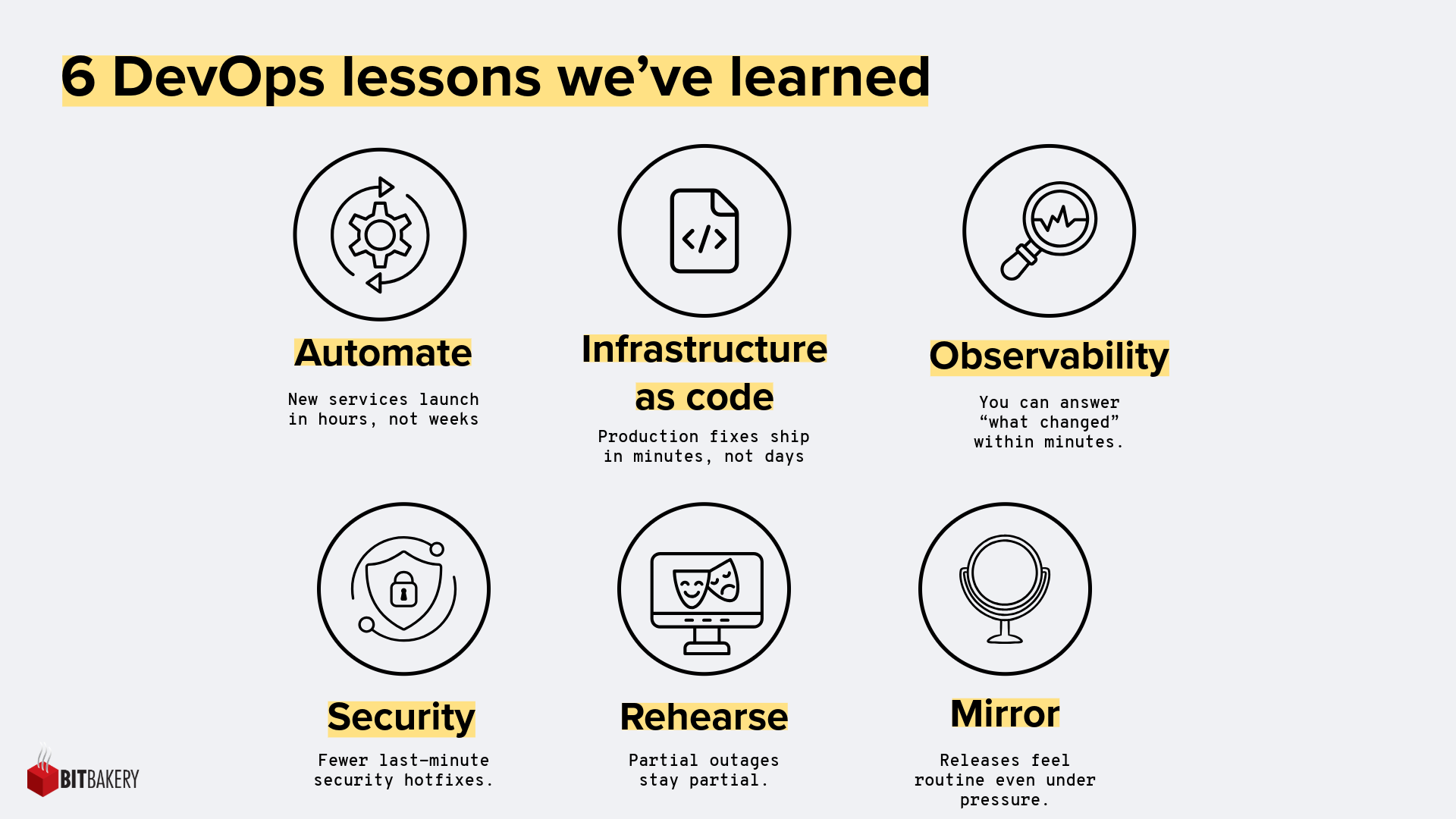“DevOps is about creating a culture of shared responsibility and continuous learning.” – Nicole Forsgren
You might not think it, but home renovations and mobile application development share much in common. You go through similar phases, from project scoping and picking contractors to inspections and final delivery.
But the similarities don’t end there. Like a home renovation, a successful mobile app will require ongoing maintenance and updates. Unlike home renovations, software development has a process that incorporates the maintenance cycle into the project from day one.
We’re talking about developer operations (DevOps), a software development life cycle (SDLC) approach that utilizes collaboration, communication, and automation between software developers and IT operations teams to ensure a software solution works today and in the future.
What is BitBakery’s approach to DevOps?
Our team works in multiple ways with clients, from providing experienced developers to support a team to designing, developing, and deploying an entire mobile app and backend system.
When a client approaches us for help with a software development project, the first thing we ask is how they manage their SDLC. To be successful, we need to know:
- What does success look like for this product over the next 6–12 months (speed, stability, compliance, cost)?
- What testing practices (unit, integration, e2e) are in place, and how reliable are they?
- Which clouds, regions, and runtimes (containers, serverless, VMs) are they using today?
- Are there regulatory requirements (PCI, HIPAA, SOC 2, GDPR, PIPEDA) we must satisfy?
- How do they currently detect, triage, and resolve production incidents?
- How often do they deploy to production, and what’s the leading blocker when they can’t deploy?
- What testing practices (unit, integration, e2e) are in place, and how reliable are they?
Having these conversations does more than help us create an effective plan. It provides us with the touchpoints we need to integrate into a client’s SDLC and team structure, ensuring we’re successful in designing, developing, and deploying a solution that exceeds expectations.
6 DevOps lessons we’ve learned
When it comes to DevOps, we’ve seen it all. Our team has a combined experience of over 25 years, and we bring that experience, along with the lessons learned from it, to each new project.
Here are six DevOps lessons that structure how we approach a project:
1. Automate infrastructure from day one
Manual setup feels quick at the start, but it hardens into brittle, one-off environments that only one person understands. Scripted, repeatable setup means every developer and every environment is created the same way, which accelerates delivery and reduces risk as you scale. It also frees your senior team members from babysitting deployments, allowing them to focus on product development.
What it looks like in action: New services launch in hours, not weeks. Deployments don’t rely on a single “hero”. “Works on my laptop” incidents fade away.
2. Treat infrastructure like version-controlled code
When your cloud configuration lives beside your application code, changes are reviewed, tested and auditable. That speeds up safe releases and makes disaster recovery a button-press away, rather than a fire drill. If something goes wrong, you can roll forward or recreate environments exactly as they were.
What it looks like in action: Clear history of who changed what and why. Staging can be rebuilt from scratch on demand. Production fixes ship in minutes, not days.
3. Build in observability from the start
Centralized logs, metrics, and traces turn “something’s wrong” into a short, specific list of suspects. You know what broke, where it broke and who’s affected without the guesswork. That shortens incidents, protects user trust, and gives leaders a clear story during post-mortems.
What it looks like in action: You can answer “what changed” within minutes. On-call interruptions drop. Post-mortems get shorter and more concrete.

4. Make staging a mirror of production
A test environment that merely resembles production misses the expensive edge cases like load balancer quirks, CDN cache rules, network permissions and rate limits. Mirror the shape of prod and scale it down. You’ll catch real problems earlier and ship with confidence when it matters.
What it looks like in action: Bugs show up in staging instead of in customers’ hands. Releases feel routine even under pressure. Rollbacks are rare and uneventful.
5. Shift security left with a human in the loop
Automated checks should identify and mitigate obvious risks early, such as vulnerable dependencies, leaked keys, and misconfigured images, while brief human reviews address context and social engineering gaps. This keeps teams moving without carrying silent security debt into launch week.
What it looks like in action: Fewer last-minute security hotfixes. No “oops, a key was pushed”. Security items are resolved inside normal sprint work.
6. Design for failure, rehearse for disaster
Assume services will hiccup. Build graceful degradation (think timeouts, retries, circuit breakers) and practice how you’ll respond so no one is improvising at 2 a.m. Regular “GameDay” drills prove that backups, people, and processes are in place before you need them.
What it looks like in action: Partial outages stay partial. Mean time to recovery shrinks release over each release. Customer updates are timely and consistent.
Following DevOps best practices like these trades late-night heroics for steady, repeatable delivery. Automating environments, keeping infrastructure in git, building observability from the start, mirroring production, shifting security left and rehearsing failure all point to the same outcomes: faster releases, fewer surprises, and a team that ships with confidence.
.png)



